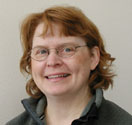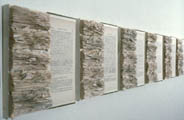margaret whiting 
waterloo, iowa | interviewed
3-6-2002
biographical sketch | artist's statements | interview clips

"Peace Forbids All Force"
altered law books
"Of the Universal Law of Nations"
altered law books
(click images for larger view)

Of the Universal Law of Nations
both copyright © 2001 Margaret Whiting | All Rights Reserved
interview clips (mp3 audio & text)
"Of the Universal Law of Nations"
Most of my work is about environmental issues. For many years, what I did was to show how patterns and textures in nature are the same from humans and other things in nature. For instance, I made a book showing how the Mississippi River looks like the human brain, and I went to the library and found imagery of brain manuals that physicians would use, and then I found imagery of the Mississippi River. And I combined them all into one book, and it looks like they blend and mesh together.
But another way that I've worked on environmental issues is placing objects from nature directly onto books. Because we go to books for knowledge and insight and truth and direction, and what I'm saying is that we can also go to nature for this.
Then I went to making altered books, and I would take old books that otherwise would end up in the landfill, and transform them into my artwork. Lately, I've been using law books a lot. I'm not really destroying the books, I'm just transforming them for a new view of our future.
I'm attracted to all the natural specimens that I collect—the rocks and the shells and the fossils. And I just love the whole process of collecting the stuff. I'm spending a lot of time arranging and rearranging my materials, and that's a big part of my creative process.
I know a lot of artists have a preconceived idea and then they go out to buy their art materials and then they follow through on the project. I work just the other way around. I gather all these natural materials—I have no idea how they're going to end up. But I gather them and I rearrange them and start seeing connections between them. And then when I find some connections, then I realize how they'll work up in my artwork and my books.
I was, of course, saddened by all the people that I heard had been
killed. I was glad for all the community effort that was going into
New York. As the week went on, I became more worried about what
the United States would do afterwards. I just didn't want any more
innocent people to be killed because of what had already happened.
Even previously to September 11th, I had been working with some law books, where I was looking at words about laws of nations at war, and I hadn't had it all figured out exactly how it was going to come about, but I knew I was going to make some artwork about that. And then after September 11th, it just made me want to become more involved in world peace, and I just put a lot more effort into it to finish those works.
"Of the Universal Law of Nations"
I think there's twelve panels altogether that are all lined up in a row, and they take up a whole wall. There are circled words on each panel, but only a few words on each panel, so to read the whole statement, you have to walk along this wall. I circled words on these panels to say it in the nicest way possible, but what I'm really doing is questioning whether it's right to kill people, even if you're doing that killing for your own country. People may say that violence is the only way to fight terrorism, but I think that there are some things that we could do to reduce terrorism in the world without resorting to violence ourselves.
I think art is just one of the ways to communicate. Visual images can be instantly recognized around the world, you don't have any language barriers, so it's a great way to communicate. In times like these, I think art can show us representations of our injuries, both physical and psychological. And art can also be used as a healing tool. Artists can be negotiators for peace. Art can facilitate dialogue and expand awareness, and it can lead to individual changes and maybe even cultural changes.
biographical sketch
Margaret Whiting was born in 1954 in the town of Virginia, Minnesota, where she also grew up. She is the third of seven children.
She earned a B.S. in Medical Technology from the University of Minnesota, and worked for ten years as a medical technologist. She has taken numerous classes in papermaking, printmaking, photography, and art history at the University of Northern Iowa, and now spends her time creating her artwork. She has exhibited her work many places, and focuses mostly on artist's books, utilizing found books and materials from nature.
She has two daughters and lives in Waterloo with her husband.
artist's statements
Peace Forbids All Force
This work was made from an old law book called Commentaries
on American Law. I used the pages of text referring to international
law between nations at war. I have circled the following words on
these pages to make my own comments about war:
Any means to produce the end...
defeats the measures which they would otherwise secure...
Peace forbids all force.
The two square areas of texture in this work are spines from other law books. They represent the extreme judgements people make during war based on the notion of good and evil: we are righteous, they are wicked, we are innocent, they are guilty, our cause is sacred, theirs is evil. The individuality, and humanness of the persons on the other side is blotted out when they are visualized as representations of all that is evil in the world. This dichotomous thinking may help us to justify our violence, but violence will lead to even more people thinking of us as evil. The use of force continues the spiral of retaliation. Only a good means will attain a good end.
Of the Universal Law of Nations
This work was made from a law book called Commentaries on American
Law by James Kent. I used those sections of law which refer
to international law between nations at war. I have circled the
following words on the law book text:
The law of nations is a code of binding obligation, as its great fundamental principles are founded in the maxims of eternal truth, in the immutable law of moral obligation...
The law of nations is the happiness and perfection of the general society of mankind, it enjoins upon every nation the observance of benevolence and good will, as well as of justice, towards its neighbors...
No act of hostility is to be commenced. No measure is to be taken that will lead to violence...
no government can justify an interference by force...
There is no exception to the rule...
But the operations of war are still prevalent. Such conduct has been condemned in all ages by the wise and virtuous...
every man is a party to the acts of his own government. Very important consequences concerning the obligations of subjects are deducible from this principle...
and it sometimes happens, that the power of making peace is committed to a body of men who have not the power to make war...
it was unlawful, as being founded in the universal law of nations, for any citizen of the United States to serve in war against any people...
Though individuals are not deemed criminal for hostilities, a question to determine is whether they are responsible...
to consider the war on each side so far as (it) relates to its effects, and to look upon...
thesematters in a moral sense to deal kindly towards all mankind, and not to bind with one nation, in contravention of those general duties which the law of nature dictates to be due to the rest of the world.



